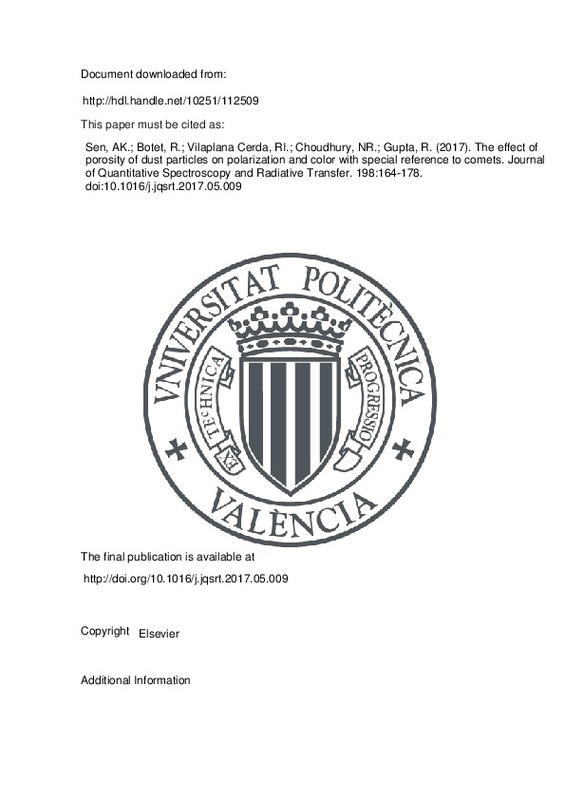JavaScript is disabled for your browser. Some features of this site may not work without it.
Buscar en RiuNet
Listar
Mi cuenta
Estadísticas
Ayuda RiuNet
Admin. UPV
The effect of porosity of dust particles on polarization and color with special reference to comets
Mostrar el registro sencillo del ítem
Ficheros en el ítem
| dc.contributor.author | Sen, A. K.
|
es_ES |
| dc.contributor.author | Botet, R.
|
es_ES |
| dc.contributor.author | Vilaplana Cerda, Rosario Isabel
|
es_ES |
| dc.contributor.author | Choudhury, Naznin R
|
es_ES |
| dc.contributor.author | Gupta, Ranjan
|
es_ES |
| dc.date.accessioned | 2018-11-14T21:03:40Z | |
| dc.date.available | 2018-11-14T21:03:40Z | |
| dc.date.issued | 2017 | es_ES |
| dc.identifier.issn | 0022-4073 | es_ES |
| dc.identifier.uri | http://hdl.handle.net/10251/112509 | |
| dc.description.abstract | [EN] Cosmic dust particles are mostly responsible for polarization of the light that we observe from astrophysical objects. They also lead to color-extinction, thermal re-emission and other scattering related phenomena. Micrometric dust particles are often made of smaller constituent (nanometric grains). They are characterized by their size (average radius), chemical composition and morphology (including porosity). In the present work, we address the question of the role of the dust particle porosity on light polarization and color, using Discrete Dipole Approximation (DDA) light scattering code. To this purpose, we develop an algorithm to generate dust particles of arbitrary values of porosity. In brief, starting from a compact spherical ensemble of dipoles,randomly the dipoles are removed one by one, such that the remaining dipoles remain connected within their neighbours. We stop the removal process when the desired porosity is obtained. Then we compute and study the optical properties of the porous dust particle. The main objective of this paper is to develop a tool to generate dust particles with an arbitrary value of porosity and to study the effect of porosity on their light scattering properties. As a possible application, we simulate cometary polarization and color values which grossly match with the observed ones for the comet 1P/Halley, leaving scope for future work. | es_ES |
| dc.description.sponsorship | R.B. thanks the Assam University, Silchar, for hospitality in the framework of 'Global Initiative for Academic Network' (GIAN) programme from MHRD, April 2016. The authors AKS and RV thank Erasmus Mundus - NAMASTE programme for funds to do this collaborative work. Finally, we are thankful to anonymous referees of this paper, due to whose comments we believe the quality of paper has improved. | |
| dc.language | Inglés | es_ES |
| dc.publisher | Elsevier | es_ES |
| dc.relation.ispartof | Journal of Quantitative Spectroscopy and Radiative Transfer | es_ES |
| dc.rights | Reconocimiento - No comercial - Sin obra derivada (by-nc-nd) | es_ES |
| dc.subject | Dust | es_ES |
| dc.subject | Extinction- dust | es_ES |
| dc.subject | Polarization- dust | es_ES |
| dc.subject | Color- comet | es_ES |
| dc.subject | Porous | es_ES |
| dc.subject | Aggregate | es_ES |
| dc.subject.classification | FISICA APLICADA | es_ES |
| dc.title | The effect of porosity of dust particles on polarization and color with special reference to comets | es_ES |
| dc.type | Artículo | es_ES |
| dc.identifier.doi | 10.1016/j.jqsrt.2017.05.009 | es_ES |
| dc.rights.accessRights | Abierto | es_ES |
| dc.date.embargoEndDate | 2019-09-01 | es_ES |
| dc.contributor.affiliation | Universitat Politècnica de València. Departamento de Física Aplicada - Departament de Física Aplicada | es_ES |
| dc.description.bibliographicCitation | Sen, AK.; Botet, R.; Vilaplana Cerda, RI.; Choudhury, NR.; Gupta, R. (2017). The effect of porosity of dust particles on polarization and color with special reference to comets. Journal of Quantitative Spectroscopy and Radiative Transfer. 198:164-178. doi:10.1016/j.jqsrt.2017.05.009 | es_ES |
| dc.description.accrualMethod | S | es_ES |
| dc.relation.publisherversion | http://doi.org/10.1016/j.jqsrt.2017.05.009 | es_ES |
| dc.description.upvformatpinicio | 164 | es_ES |
| dc.description.upvformatpfin | 178 | es_ES |
| dc.type.version | info:eu-repo/semantics/publishedVersion | es_ES |
| dc.description.volume | 198 | es_ES |
| dc.relation.pasarela | S\337492 | es_ES |
| dc.contributor.funder | European Commission |







![[Cerrado]](/themes/UPV/images/candado.png)

